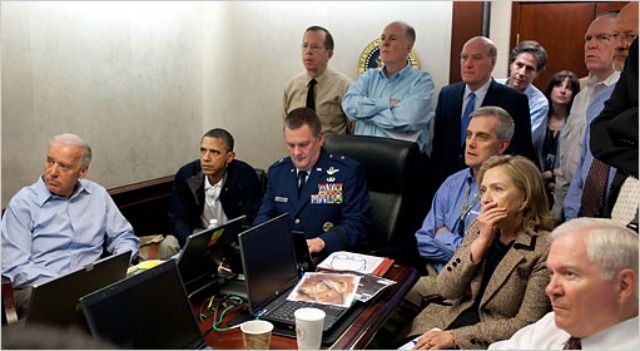WH Followed Bin Laden Raid Live
For an intelligence community that had endured searing criticism for a string of intelligence failures over the past decade, Bin Laden’s killing brought a measure of redemption. For a military that has slogged through two, and now three vexing wars in Muslim countries, it provided an unalloyed success. And for a president whose national security leadership has come under question, it proved an affirming moment that will enter the history books.
The raid was the culmination of years of painstaking intelligence work, including the interrogation of C.I.A. detainees in secret prisons in Eastern Europe, where sometimes what was not said was as useful as what was. Intelligence agencies eavesdropped on telephone calls and e-mails of the courier’s Arab family in a Persian Gulf state and pored over satellite images of the compound in Abbottabad to determine a “pattern of life” that might decide whether the operation would be worth the risk.
As more than a dozen White House, intelligence and Pentagon officials described the operation on Monday, the past few weeks were a nerve-racking amalgamation of what-ifs and negative scenarios. “There wasn’t a meeting when someone didn’t mention ‘Black Hawk Down,’ ” a senior administration official said, referring to the disastrous 1993 battle in Somalia in which two American helicopters were shot down and some of their crew killed in action. The failed mission to rescue hostages in Iran in 1980 also loomed large.
Administration officials split over whether to launch the operation, whether to wait and continue monitoring until they were more sure that Bin Laden was really there, or whether to go for a less risky bombing assault. In the end, President Obama opted against a bombing that could do so much damage it might be uncertain whether Bin Laden was really hit and chose to send in commandos. A “fight your way out” option was built into the plan, with two helicopters following the two main assault copters as backup in case of trouble.
On Sunday afternoon, as the helicopters raced over Pakistani territory, the president and his advisers gathered in the Situation Room of the White House to monitor the operation as it unfolded. Much of the time was spent in silence. Mr. Obama looked “stone faced,” one aide said. Vice President Joseph R. Biden Jr. fingered his rosary beads. “The minutes passed like days,” recalled John O. Brennan, the White House counterterrorism chief.
The code name for Bin Laden was “Geronimo.” The president and his advisers watched Leon E. Panetta, the C.I.A. director, on a video screen, narrating from his agency’s headquarters across the Potomac River what was happening in faraway Pakistan.
“They’ve reached the target,” he said.
Minutes passed.
“We have a visual on Geronimo,” he said.
A few minutes later: “Geronimo EKIA.”
Enemy Killed In Action. There was silence in the Situation Room.
Finally, the president spoke up.
“We got him.”


